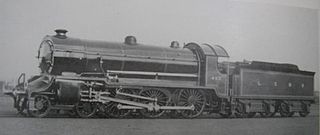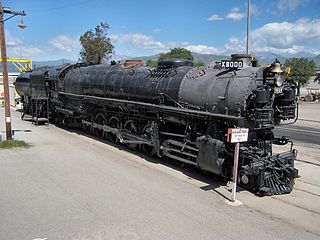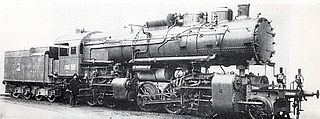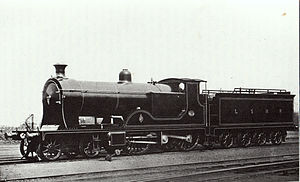
Main components found on a typical steam locomotive include:

Under the Whyte notation for the classification of steam locomotives, 4-2-2 represents the wheel arrangement of four leading wheels on two axles, two powered driving wheels on one axle, and two trailing wheels on one axle.

The GWR 4100 Class was a class of steam locomotives in the Great Western Railway (GWR) of the United Kingdom.

The LSWR/SR H15 class was a class of 2-cylinder 4-6-0 steam locomotives designed by Robert Urie for mixed-traffic duties on the LSWR. Further batches were constructed by Richard Maunsell for the Southern Railway after 1923. They were given the nickname of "Junior King Arthur" due to the size of their driving wheels, the S15 and their N15 cousins had driving wheels which had a diameter of 5 foot and 7 inches and 6 foot and 7 inches respectively.

The Union Pacific Railroad 9000 Class was a class of 88 steam locomotives, built by ALCO for the Union Pacific between 1926 and 1930.

The Highland Railway's Clan Class was a class of passenger 4-6-0 steam locomotives designed by Christopher Cumming. The design is derived from that of the slightly earlier Clan Goods although the similarity is more visual than real. The first four were built in 1919, and the remaining four in 1921.

An 0-2-2, in the Whyte notation for the classification of steam locomotives by wheel arrangement, is one that has two coupled driving wheels followed by two trailing wheels, with no leading wheels. The configuration was briefly built by Robert Stephenson and Company for the Liverpool and Manchester Railway.
David Jones (1834–1906) was locomotive superintendent of the Highland Railway between 1870 and 1896. He was credited with the design of the first British 4-6-0, which was strongly influenced by the Scottish locomotive design for Indian Railways. The 4-6-0 wheel arrangement that appeared in 1894, quickly became the most common locomotive for main line passenger and mixed traffic work in Britain.

The London and South Western Railway L11 class was a class of 4-4-0 steam locomotives designed for mixed traffic work. They were introduced in 1903 and were nicknamed "Large Hoppers". As with most other Drummond productions, the locomotive had two inside cylinders and Stephenson link valve gear.

The London and South Western Railway K10 Class was a class of 40 4-4-0 steam locomotives designed for mixed traffic work. They were introduced on the London and South Western Railway in 1901 and 1902 to the design of Dugald Drummond, where they earned the nickname "Small Hoppers".

The LSWR Class T14 was a class of ten 4-6-0 locomotives designed by Dugald Drummond for express passenger use on the London and South Western Railway and constructed at Eastleigh in 1911–12.

The LSWR D15 class 4-4-0 was the last steam locomotive design by Dugald Drummond for the London and South Western Railway in 1912. By 1912, Dugald Drummond had built several classes of unsuccessful 4-6-0 express passenger locomotives. The result of these failures was that when he designed what was to be his last class in 1911, a new 4-4-0 design emerged from Eastleigh Works in February 1912, with what was to be the first of his D15 class.
A compound locomotive is a steam locomotive which is powered by a compound engine, a type of steam engine where steam is expanded in two or more stages. The locomotive was only one application of compounding. Two and three stages were used in ships, for example.

The South African Railways Class 16E 4-6-2 of 1935 is a class of passenger steam locomotive.
A divided drive locomotive is a steam locomotive that divides the driving force on its wheels by using different cylinders to power different pairs of driving wheels in order to give better weight distribution and reduce "hammer blow" which can be damaging to the track, or else to enable the wider spacing of the driving wheels to accommodate a larger firebox.
Under the Whyte notation for the classification of steam locomotives, 4-2-2-0 represents the wheel arrangement of four leading wheels on two axles, four independently driven driving wheels on two axles, and no trailing wheels. The arrangement became known as double single.

A steam motor is a form of steam engine used for light locomotives and light self-propelled motor cars used on railways. The origins of steam motor cars for railways go back to at least the 1850s, if not earlier, as experimental economizations for railways or railroads with marginal budgets. These first examples, at least in North America, appear to have been fitted with light reciprocating engines, and either direct or geared drives, or geared-endless chain drives. Most incorporated a passenger carrying coach attached to the engine and its boiler. Boiler types varied in these earlier examples, with vertical boilers dominant in the first decade and then with very small diameter horizontal boilers. Other examples of steam motor cars incorporated an express-baggage or luggage type car body, with coupling apparatus provided to allow the steam motor car to draw a light passenger coach.

The Central South African Railways Rack 4-6-4RT of 1905 was a South African steam locomotive from the pre-Union era in Transvaal Colony.

The MÁV class 601 is a class of Hungarian four cylinder Mallet -type locomotives, which was designed to haul long and very heavy cargo on very steep railway tracks. With their 22.5 meter length and 2200 KW power, they were the largest and most powerful steam locomotives which have ever built before the First World War in Europe.
The L&YR 2-10-0 was a prospective design for a class of 2-10-0 steam locomotives on the Lancashire and Yorkshire Railway. Initial designs were made by George Hughes between 1913 and 1914, but none of the class were built. If they had been, these would have been the UK's first 10-coupled locomotives in regular service.















